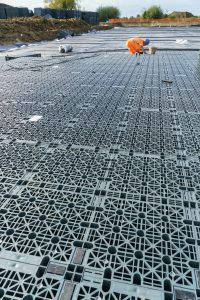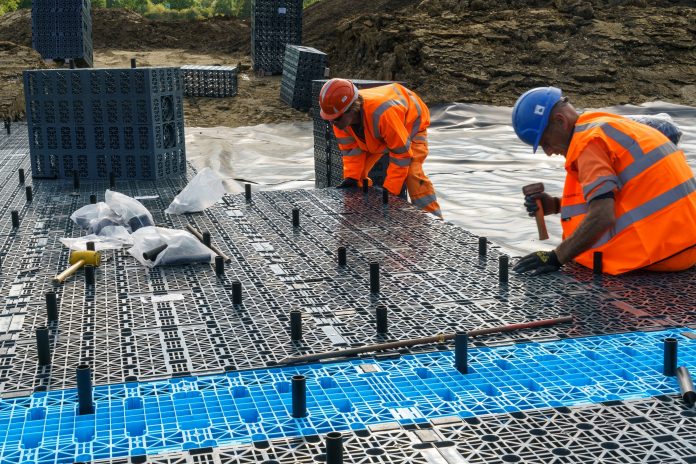Martin Lambley, Product Manager for Stormwater at Wavin, explains how the effective use of sustainable urban drainage solutions (SuDS) can support change in the ways we plan, design and build towns and cities
Across the UK and Europe, infrastructure is under threat. Buildings are ageing, urbanisation is increasing, climate change is becoming an ever-greater risk, and the threat of flooding is not going away.
British weather is far from predictable – while the summer of 2018 gave us record-breaking temperatures and hosepipe bans, it also brought torrential downpours and flash flooding. Cast your mind back even further to the winter of 2017 and you’ll remember that heavy rain caused widespread damage and disruption across the country.
The frequency of these extreme weather events in recent years is one of a number of factors that has put the issue of flooding in the spotlight. Research carried out by the UN Department of Economic & Social Affairs has suggested that 68% of the global population will live in cities by 2050.
However, most current urban infrastructure was not built with this scale of population increase in mind, and city authorities and planners across the world are already considering how to futureproof for major increases in demand for all public services and utilities.
Of course, as the saying goes: “Prevention is better than cure”, and while there are ways to tackle flood risk remedially, building towns and cities with integrated, coordinated drainage systems in mind is the most effective way to address the threat.
 Changing the approach
Changing the approach
In previous years, infiltration has been the preferred and simplest way to implement stormwater management. Permeable ground, such as grass, field and woodland, captures and absorbs surface water, which then infiltrates through the layers of soil.
However, urbanisation – and the associated tarmacking and cementing of outdoor spaces – has reduced the amount of permeable ground available. The result is that during storms and extreme rainfall, there is simply nowhere for water to drain away to, increasing the risk of “pluvial” – or rain-related – flooding.
All of this means that the typical methods of stormwater management – relying on infiltration or directing excess water straight into rivers and watercourses via stormwater sewers – are no longer viable as a means of fully protecting infrastructure in the long term.
The rise of SuDS
With all this mind, urban planners and developers are having to rethink the ways water is managed and search for smarter drainage solutions that are more effective at protecting infrastructure.
Sustainable Drainage Systems (SuDS) have been created with this need in mind. These are specialist systems designed to mimic Mother Nature, collecting and managing stormwater at source, allowing it to be released back into the environment via infiltration and into to sewers and watercourses at a manageable rate. Working in tandem with other water management systems, SuDS can help significantly reduce the risk of flooding.
There are many different kinds of SuDS available. “Soft” SuDS, for example, use green landscaping, such as swales and soakaways, to manage water within a site. Soft SuDS are ideal for holding back water for later release, but can take up considerable space, limiting their viability.
On projects with restricted space and urban developments, like towns and cities, “engineered” SuDS become a more suitable option. These often consist of tanks that are buried underground, an are capable of the same water storage potential as “soft” alternatives without taking up valuable (and often simply unavailable) room on the surface. Collected stormwater is directed into the tanks and then released back into the surrounding soils through infiltration, or released at a controlled rate into the drainage network or local watercourse.
Engineered SuDS and planning
Planners and specifiers are already well aware of the importance of considering SuDS at the early stages of a project. That said, and with the growing threats of urbanisation and climate change in mind, there is now a need for increased collaboration across sectors and industries to enhance rain and stormwater management planning.
In the last 12 months, the UK government has announced a number of new policies designed to improve rain and stormwater management. Water UK has released a pre-implementation version of Sewers for Adoption 8, which, for the first time, includes guidance on adopting some SuDS techniques, including geocellular storage tanks. This is a significant step in delivering a better managed and more integrated approach to rain and stormwater management.
The challenge now is to ensure all those involved in the planning, design and implementation of sustainable drainage are aware of the different solutions available, and how they can be implemented most effectively. In future, local authorities, planners and developers will need to work even more closely with installers and manufacturers of such solutions to understand what will work best on their projects. At the same time, manufacturers can provide proactive support by offering dedicated education workshops, training sessions and resources for planners and developers, looking at the potential of SuDS in different scenarios, and giving insights into the solutions available in line with new legislation.
Looking ahead
The implementation of Sewers for Adoption 8 is set to have a significant impact on the ways in which sustainable drainage is specified and adopted. Only time will tell whether this will be positive or negative, but one thing’s for sure, it’s a step in the right direction. Wavin offer a wide range of sustainable drainage solutions suitable for a multitude of applications. To find out more visit: www.wavin.co.uk
Martin Lambley
Product Manager for Stormwater
Wavin
Tel: +44 (0)1709 856300
Twitter: @WavinUK
LinkedIn: wavin-limited
Youtube: WavinUK







![[VIDEO]What to expect when you’re inspecting: Using DorTrak for fire door inspections](https://www.pbctoday.co.uk/news/wp-content/uploads/2025/02/maxresdefault-218x150.jpg)






